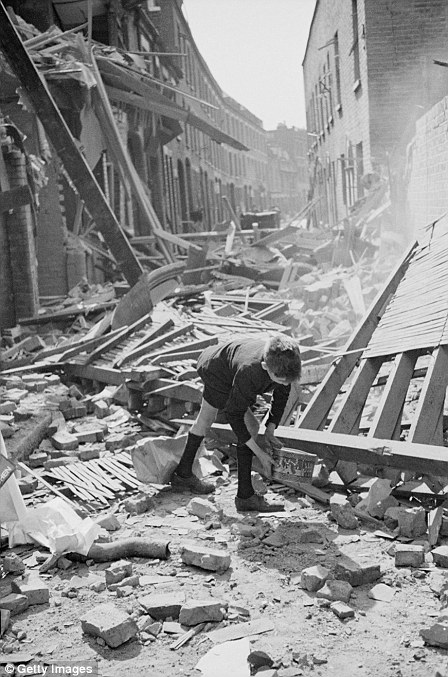A boy retrieves an item from a rubble-strewn street of East London after German bombing raids in the first month of the Blitz, September 1940
The Blitz began on September 7, 1940, and was the most intense bombing campaign Britain has ever seen.
Named after the German word ‘Blitzkrieg’, meaning lightning war, the Blitz claimed the lives of more than 40,000 civilians.
Between September 7, 1940, and May 21, 1941, there were major raids across the UK with more than 20,000 tonnes of explosives dropped on 16 British cities.
London was attacked 71 times and bombed by the Luftwaffe for 57 consecutive nights.
The City and the East End bore the brunt of the bombing in the capital with the course of the Thames being used to guide German bombers. Londoners came to expect heavy raids during full-moon periods and these became known as ‘bombers’moons’.
More than one million London houses were destroyed or damaged and of those who were killed in the bombing campaign, more than half of them were from London.
In addition to London’s streets, several other UK cities – targeted as hubs of the island’s industrial and military capabilities – were battered by Luftwaffe bombs including Glasgow, Liverpool, Plymouth, Cardiff, Belfast and Southampton and many more.
Deeply-buried shelters provided the most protection against a direct hit, although in 1939 the government refused to allow tube stations to be used as shelters so as not to interfere with commuter travel.
However, by the second week of heavy bombing in the Blitz the government relented and ordered the stations to be opened. Each day orderly lines of people queued until 4pm, when they were allowed to enter the stations.
Despite the blanket bombing of the capital, some landmarks remained intact – such as St Paul’s Cathedral, which was virtually unharmed, despite many buildings around it being reduced to rubble.
Hitler intended to demoralise Britain before launching an invasion using his naval and ground forces. The Blitz came to an end towards the end of May 1941, when Hitler set his sights on invading the Soviet Union.
Other UK cities which suffered during the Blitz included Coventry, where saw its medieval cathedral destroyed and a third of its houses made uninhabitable, while Liverpool and Merseyside was the most bombed area outside London.
There was also major bombing in Birmingham, where 53 people were killed in an arms works factory, and Bristol, where the Germans dropped 1,540 tons of high explosives and 12,500 incendiaries in one night – killing 207 people.
